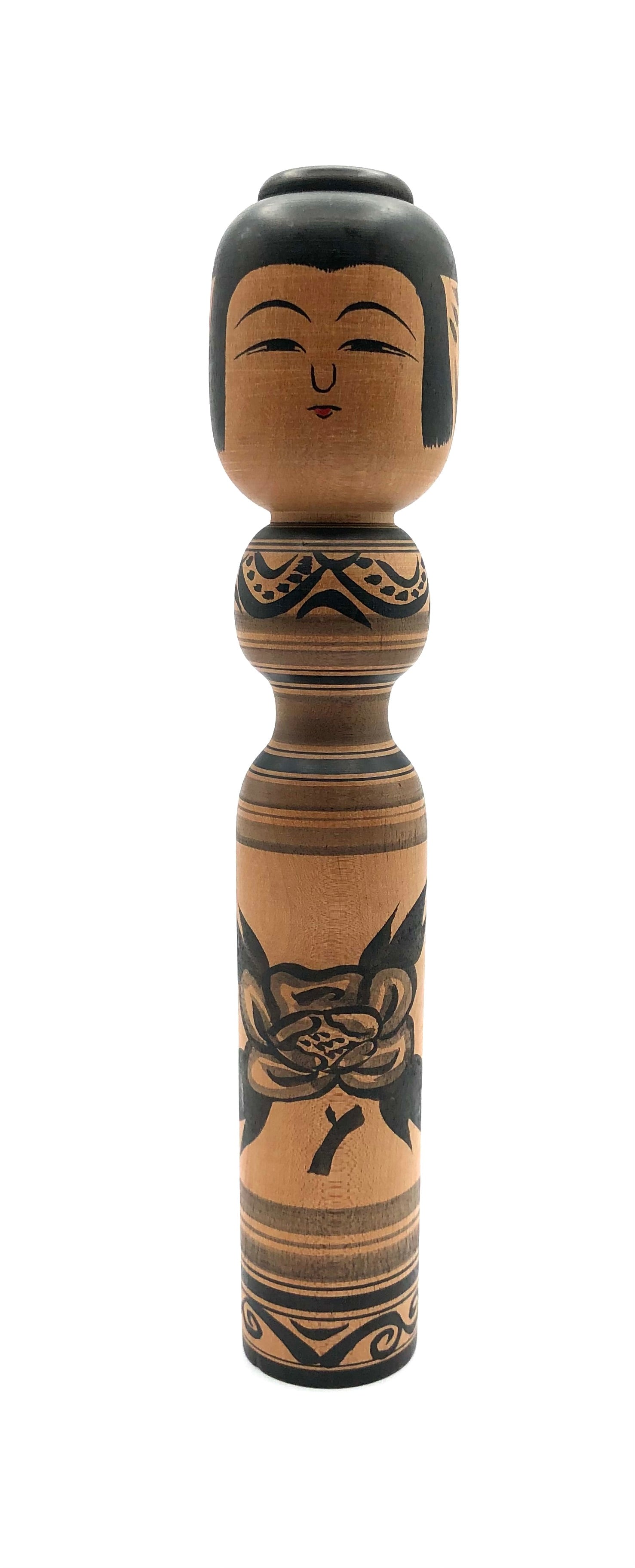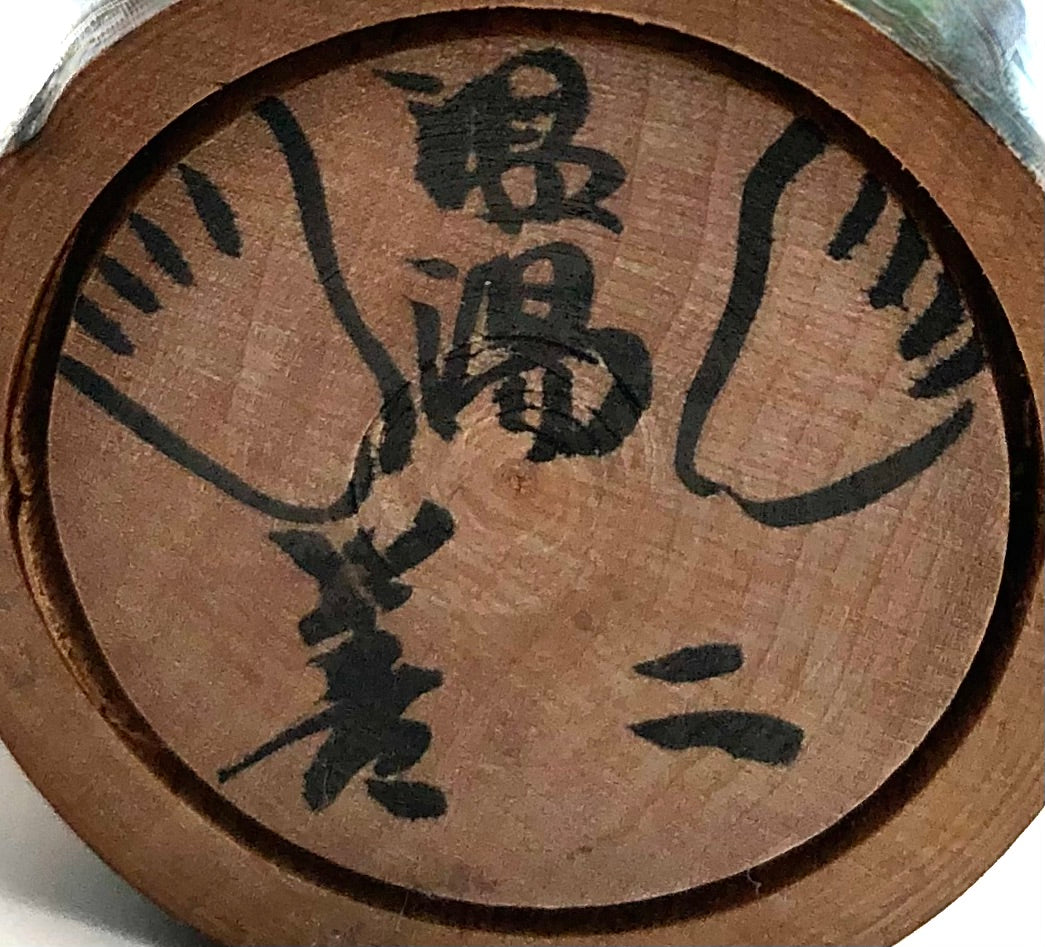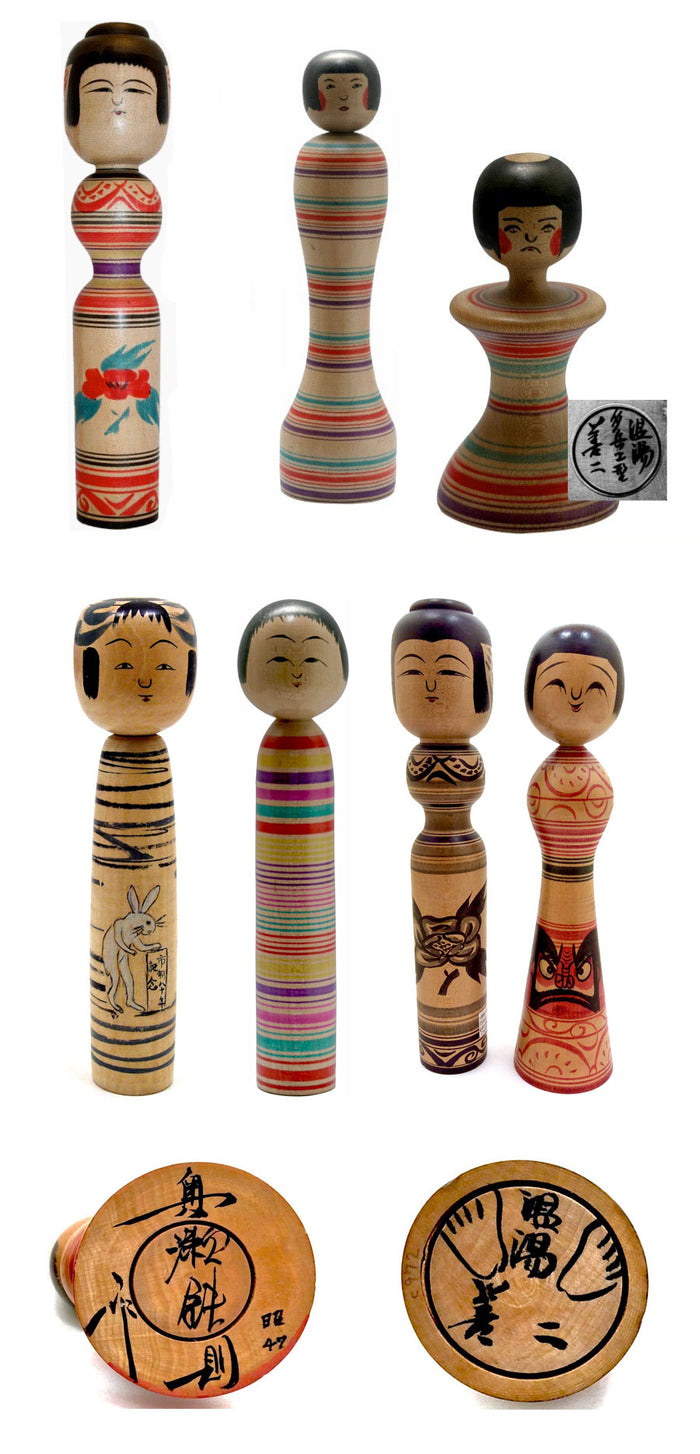

Vintage Japanese Traditional Tsugaru Kokeshi by Sato, Zenji (1925- 1985)
Dimensions: 10-0” h
Tsugaru kokeshi, which originated in Aomori Prefecture, in the region of the same name, are sometimes also known as Nuruyu dolls, because they made their appearance at Nuruyu Onsen, in the city of Kuroishi.
This black and natural wood Kokeshi is beautifully lathe-turned and rare because it is only one color, and resembles the face of Buddha as well as having a flower that had special meaning for the Samurai. Unlike craftsmen of the other Dento strains, Tsugaru artists were creating dolls for collectors, rather than staying within the boundaries of the original, typical Kokeshi, which were made as toys. This doll Nuruyu is one of the youngest of this style. With her wasp-like, concave/convex figure, she is the most commonly seen type of this family. This form of doll typically has an egg-like head, as opposed to the standard round head with a ‘chignon’, (top knot). With circular lines on the top, and an ‘Okappa’ style of hair that is trimmed around the neck, she is minimally ornamented. The doll has what is called a Maru-Bana, (round nose). She has a round chest, thick waist, and cone-shaped lower body, on which there is a Camellia, which for the Samurai was a symbol of steadfastness and bravery. It is used to define the front of the Kimono. Framing the floral image are Rokoru moyo style varying widths horizontal line-work in black above and below the image.
Of all the features illustrated on this doll, the most notable and RARELY seen are hand-painted ‘feet’ on the bottom, with the artist’s script signature. To read more about this Family of Kokeshi makers go to: https://mingeiarts.com/collections/tsuchiyu-kei-family.
Condition: Outstanding excellent, impressive, and beautiful. A RARE piece for the collector of traditional Kokeshi to complete one’s collection. There are no chips, cracks, breaks, missing pieces, or restoration, and retains its original details and finish with an exceptional ‘hand’ (touch), including the three-dimensional form, artwork, color, and composition. The piece meets all the standards of the vintage collectible Traditional Tsuchiyu Kokeshi.

Japanese Traditional Kokeshi
Tsugaru-Kei (Family)
Prefecture: Aomori
Origin:
Tsugaru is the youngest of the eleven traditional kokeshi strains. They began in the 1920s. A Tsugaru doll has a great deal of variety in its shape and pattern. The Tsugaru Kokeshi are made from a solid piece of wood, created using a difficult reverse lathe technique. The Tsugaru Kokeshi is the only strain to still use this method. The Tsugaru-kei developed after adults took an interest in buying more kokeshi as souvenirs from trips to the hot-spring resorts. Tsugaru dolls, which originated in the Aomori Prefecture in the region of the same name, are sometimes also known as Nuruyu dolls, originally fabricated by Hidetaro Mori. They made their appearance at Nuruyu (“lukewarm") Onsen, in the city of Kuroishi.
Collector's note – characteristics/painting style:
The dolls have round chests, thin waists, and cone-shaped lower bodies on which human faces are painted. They will strike you as quite unusual and interesting. One of the distinguishing features of this family of Kokeshi is a heavier hairstyle, in that most are Okappa styling, which has a full head of hair or mostly full head of hair in a bob style, and a chignon or topknot, without much decoration on the head. The hair is painted solid black, with brush strokes visible on the edges of the bangs and hair. One can easily recognize a Tsugaru doll because many will have the face of Daruma painted on the lower half of the body, with flowers painted on the doll looking quite realistic. The short history of the strain may not yet have given it enough time to utilize flowers such as White irises, peonies, and camellias. Stripes (Rokuro Moyo) appear at the top, center, or bottom of the doll. Some doll motifs, such as Ainu (native designs), that replace the Daruma image have simplified versions of peonies, irises, cherry blossoms, and camellia.
NOTE: We have seen a few dolls with the image of Daruma that were created by Sato, Zenji, (b.1925), in which he drew “feet” on the bottom with his signature, which was inspired by his mentor and master, Mori, Hidetori, (b1895), who used the same interesting humorous addition since kokeshi never incorporated feet.

Leading, Craftsmen:
Abo, Muchihide, 1950, (Hirosaki, Aomori) - Master: Sato, Zenji. No additional published information
Mori, Hidetaro, 1895 (Nuruya, Aomori) - Master: Mori, Motokichi. No additional published information
Mori, Mitsuo, 1955 - Masters: Mori, Hidetaro & Shin-ichi. No additional published information
Muramoto, Fumio, 1941- Master, Mori, Senzo. No additional published information
Okuse, Tetsunori, 1940 - Master: Mori, Hidetaro. No additional published information
Sato, Yoshiki, 1949, (Omani, Aomori) - Master: Mori, Hidetaro. No additional published information
Sato, Zenji, 1925, Master: Mori, Hidetaro. No additional published information
Explore & Learn More about Tsugaru-Kei (Family)